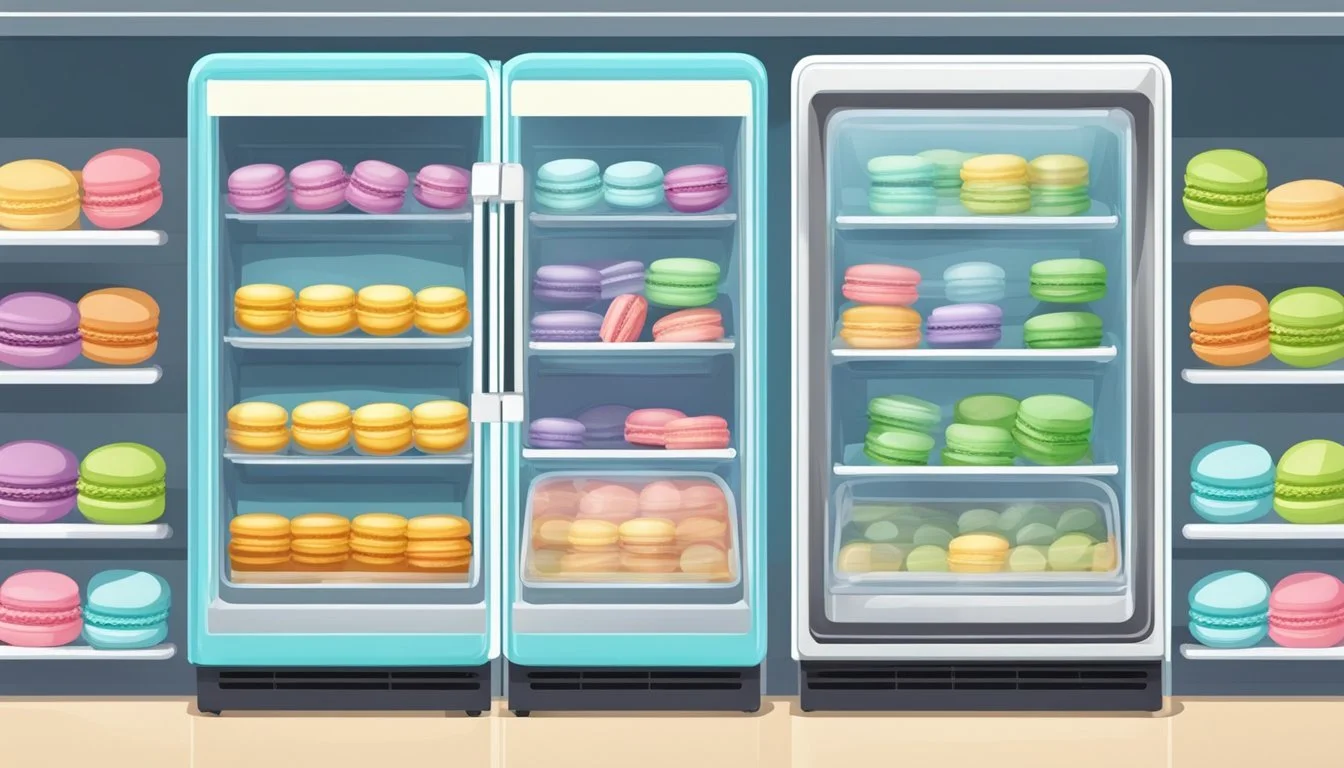Frozen vs Fresh Macarons: A Sweet Comparison
Macarons, those delicate French confections, have gained immense popularity in recent years. As demand grows, many wonder about the differences between fresh and frozen macarons. Both fresh and frozen macarons can maintain excellent quality when handled properly, with many professional bakeries freezing their products for distribution without compromising taste or texture.
Freezing macarons allows bakers to prepare these treats in advance, saving time and effort for special events or busy periods. When frozen correctly, macarons can retain their delightful flavors and crisp-yet-chewy texture for up to 3-4 months. This preservation method has become common practice among large macaron producers who ship their products worldwide.
While fresh macarons offer immediate enjoyment, frozen ones provide convenience and longevity. The key lies in proper storage and thawing techniques to ensure the best eating experience. Understanding the nuances between fresh and frozen macarons can help consumers make informed choices and appreciate these delectable treats in various settings.
Understanding Macarons
Macarons are delicate French sandwich cookies known for their smooth, domed tops and crisp exteriors with chewy interiors. These colorful treats come in a variety of flavors and fillings, combining textures and tastes in a single bite-sized confection.
Composition and Flavor Profiles
Macarons consist of two almond meringue shells sandwiching a creamy filling. The shells have a slight crunch that yields to a soft, chewy texture. Flavors range from classic vanilla and chocolate to exotic combinations like lavender-honey or matcha green tea.
Fillings play a crucial role in macaron flavor profiles. Popular options include:
Ganache: A smooth chocolate mixture
Buttercream: Light and fluffy, easily flavored
Fruit jams: Adds tartness and natural sweetness
The almond flour base imparts a subtle nutty taste, while the meringue provides sweetness. Food coloring is often used to create vibrant, eye-catching shells that hint at the flavors within.
Macaron Ingredients and Recipe
The basic macaron recipe calls for:
Almond flour
Powdered sugar
Egg whites
Granulated sugar
These simple ingredients combine to create the distinctive macaron texture. The almond flour and powdered sugar form the base, while whipped egg whites create the airy meringue structure.
The recipe involves creating a "macaronage" - a process of folding the dry ingredients into the meringue. This step is crucial for achieving the right consistency. Over-mixing can lead to flat, cracked shells, while under-mixing results in peaked tops.
Baking Techniques and Equipment
Proper technique and equipment are essential for successful macarons. Key tools include:
Piping bag with a round tip
Baking sheets lined with parchment paper or silicone mats
Oven thermometer for precise temperature control
Piping requires a steady hand to create uniform circles. Many bakers use templates underneath the parchment paper as guides.
Climate plays a significant role in macaron baking. Humidity can affect the shells' ability to form a proper "skin" before baking. Some bakers use a fan to create airflow and speed up this process.
Oven temperature and baking time are critical. Most recipes call for baking at 300-325°F (150-165°C) for 12-15 minutes. Proper baking results in the characteristic "feet" - the ruffled edges at the base of each shell.
The Freshness Factor
Macarons reach their peak flavor and texture when stored properly. The storage method and environment significantly impact how long these delicate French confections maintain their quality.
Optimal Conditions for Fresh Macarons
Fresh macarons thrive at room temperature, ideally between 68-72°F (20-22°C). Humidity levels should be kept low to prevent moisture absorption, which can soften the crisp shell.
Store macarons in an airtight container to protect them from air exposure. Place parchment paper between layers to prevent sticking.
For short-term storage up to 2-3 days, keep macarons at room temperature. This allows the flavors to develop and maintains the ideal texture - crisp exterior with a soft, chewy interior.
Shelf Life of Fresh Macarons
Freshly made macarons typically last 2-3 days at room temperature. After this time, the texture may begin to change, with the shell softening and losing its crispness.
Refrigeration can extend the shelf life to 5-7 days. When storing macarons in the fridge, place them in an airtight container and allow them to come to room temperature before serving.
For longer storage, freezing is the best option. Properly frozen macarons can last up to 3-4 months without significant loss of quality. Thaw frozen macarons in the refrigerator overnight before bringing them to room temperature for serving.
Preservation Techniques
Proper storage is crucial for maintaining the quality and texture of macarons. Freezing offers an effective way to extend their shelf life while preserving their delicate structure and flavor.
Freezing Unfilled Macaron Shells
Unfilled macaron shells freeze exceptionally well. Place the shells in a single layer on a baking sheet and freeze until solid, about 1-2 hours. Once frozen, transfer them to an airtight container, separating layers with parchment paper to prevent sticking.
Properly stored, unfilled shells can last up to 3-4 months in the freezer. This method is ideal for batch preparation or preserving excess shells.
To thaw, remove the desired number of shells from the freezer and let them come to room temperature for about 30 minutes. This gradual thawing helps prevent condensation and maintains the crisp exterior.
Freezing Filled Macarons
Filled macarons can also be frozen, but the success depends on the type of filling used. Ganache and buttercream fillings generally freeze well, maintaining their texture upon thawing.
Place filled macarons in a single layer in an airtight container. Separate layers with parchment paper to protect the delicate shells. Filled macarons typically last 1-2 months in the freezer.
To thaw, transfer the macarons to the refrigerator for a few hours, then bring them to room temperature before serving. This slow thawing process helps preserve the texture of both the shells and the filling.
Can You Freeze Macarons with All Fillings?
Not all macaron fillings freeze equally well. Buttercream, ganache, and most chocolate-based fillings freeze successfully. However, fillings with high water content like jams, curds, and some fruit-based creams may alter the texture of the macaron shells upon thawing.
For macarons with these fillings, it's best to freeze the shells separately and add the filling after thawing. If freezing is necessary, use an extra layer of protection such as plastic wrap around each macaron to minimize moisture transfer.
Experiment with small batches to determine which fillings freeze well. Some flavors may intensify or change slightly after freezing, so consider this when planning your macaron menu.
Defrosting and Serving
Proper defrosting and serving techniques are crucial for preserving the quality of frozen macarons. Patience and careful handling ensure these delicate treats maintain their texture and flavor.
Proper Thawing Techniques
Thaw frozen macarons gradually to prevent condensation and texture damage. Remove them from the freezer and place them in the refrigerator for 3-4 hours. This slow transition helps maintain their delicate structure.
After refrigeration, let macarons sit at room temperature for 30 minutes. This final step brings out their full flavor profile.
Avoid using microwaves or heating devices, as these can ruin the macaron's texture.
Ensuring Quality and Flavor After Freezing
Properly frozen and thawed macarons should retain their original quality. Check for any signs of freezer burn or ice crystals, which may indicate improper storage.
The shells should remain crisp, while the filling stays soft and flavorful. If macarons seem slightly less crisp, place them in a 200°F (95°C) oven for 5 minutes, then cool before serving.
Store thawed macarons in an airtight container at room temperature for up to 2 days. Refrigerate if not consuming immediately.
Preparing for a Special Event
For events, plan ahead to ensure macarons are at their best. Transfer frozen macarons to the refrigerator 24 hours before the event.
Two hours prior to serving, move them to room temperature. This timing allows flavors to fully develop and textures to reach optimal consistency.
Arrange macarons on a decorative platter just before guests arrive. Avoid stacking to prevent damage to the delicate shells.
Consider preparing a variety of flavors to cater to different preferences. Label each type for guest convenience.
Storage Solutions and Tips
Proper storage is crucial for maintaining the quality and flavor of macarons. The right techniques can extend shelf life and preserve texture, whether storing fresh or frozen macarons.
Best Practices for Macaron Storage
Store macarons in airtight containers to prevent moisture and odors from affecting their delicate texture. Place parchment paper between layers to avoid sticking. For short-term storage, keep macarons at room temperature for 24 hours to allow flavors to develop. Refrigerate filled macarons for up to 3 days.
For longer storage, freezing is effective. Wrap individual macarons in plastic wrap before placing them in freezer bags or airtight containers. This method preserves macarons for 3-4 months without compromising taste or texture.
When thawing frozen macarons, transfer them to the refrigerator 24 hours before serving. Allow them to reach room temperature before eating to enhance flavor.
Avoiding Common Storage Mistakes
Avoid storing macarons in humid environments, as moisture can soften the shells. Don't keep them near strong-smelling foods, as macarons easily absorb odors. Refrain from stacking macarons directly on top of each other without protective layers.
Never store unfilled macaron shells in the refrigerator, as this can make them soggy. Instead, keep unfilled shells at room temperature in an airtight container for up to a week.
Don't leave macarons exposed to air for extended periods. Always return them to their storage container promptly after serving.
Container and Packaging Options
Airtight containers are ideal for macaron storage. Choose containers with tight-fitting lids to prevent air exposure. Plastic or glass containers work well, but avoid those with strong plastic odors.
Specialized macaron boxes with individual compartments offer excellent protection for delicate shells. These boxes are perfect for gifting or transporting macarons.
For freezer storage, use freezer-safe bags or containers. Double-wrap macarons in plastic wrap before placing them in freezer bags to prevent freezer burn.
Wax paper or parchment paper is essential for separating layers of macarons in containers. This prevents sticking and preserves the integrity of the delicate shells.
Conclusion
Frozen and fresh macarons each offer unique advantages. Fresh macarons provide an unparalleled texture and flavor experience when consumed shortly after baking. Their delicate shells and creamy fillings are at their peak within 24-48 hours.
For longer storage, freezing macarons is an excellent option. Properly stored frozen macarons can maintain quality for 3-4 months. This allows for bulk preparation and enjoyment over an extended period.
Homemade macarons can be frozen successfully if stored properly. Place them in airtight containers with parchment paper between layers to prevent sticking. Thaw frozen macarons in the refrigerator for best results.
Fresh macarons stored in the refrigerator typically last 4-5 days. For optimal freshness, consume within this timeframe. Beyond that, freezing is recommended to preserve quality.
Both frozen and fresh macarons have their place. Fresh macarons offer immediate gratification, while frozen ones provide convenience and longevity. The choice depends on individual preferences and storage needs.







